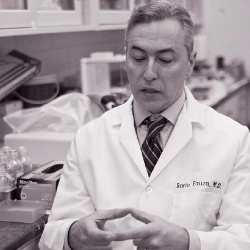 Every year, more than 100,000 babies are born in the United States with major birth defects. It was just one of those cases, in 1995, that convinced pediatric surgeon Dario Fauza, MD, that there had to be a better way to help these children. The baby was born with a condition called ectopia cordis – a birth defect in which the heart is formed outside of its body. The painful reality was that this baby had an otherwise normal heart, but because it left an empty space in its chest, other organs could not form properly. Ectopia cordis is a very rare defect, which can sometimes be treated surgically.
Every year, more than 100,000 babies are born in the United States with major birth defects. It was just one of those cases, in 1995, that convinced pediatric surgeon Dario Fauza, MD, that there had to be a better way to help these children. The baby was born with a condition called ectopia cordis – a birth defect in which the heart is formed outside of its body. The painful reality was that this baby had an otherwise normal heart, but because it left an empty space in its chest, other organs could not form properly. Ectopia cordis is a very rare defect, which can sometimes be treated surgically.
Fauza, who is Assistant Professor of Surgery at Harvard Medical School, understood that deadly birth defects like this one may one day be treatable through tissue engineering. He could see technology coming together to create possibilities: improvements in ultrasound and MRI imaging could detect defects in utero and map them in three dimensions; new advances in stem cell research and biomaterials were making it possible to create tissue patches that resemble muscle, cartilage, and bone; and surgeons were perfecting methods of operating on tiny bodies while still cradled in the womb.
The ability to create patches and spare parts for tissues and organs is usually thought of as a panacea for an aging population, but the first applications for this repair kit are likely to be for those just starting out in life. If Fauza’s plan falls into place, clinical trials for treating birth defects with tissues grown in the lab might be less than a year away.
The reason for this remarkable progress can be traced to the power of fetal stem cells. Easily obtained from a few drops of amniotic fluid, fetal stem cells can give rise to many types of tissue and grow a lot faster than other stem cells. A graft from amniotic stem cells “has both structural integrity and elasticity, and it’s very forgiving as we manipulate it surgically,” said Fauza. When patched into the body, amniotic fetal stem cell grafts quickly draw in a network of blood vessels to help them thrive, and because they come from the same baby that is being treated, there is no immunological rejection. And like adult stem cells, these cells do not require the destruction of a human embryo.
“...What we’ve seen so ar allows us to have realistic expectations that tissue engineering in our lifetime will eventually be a substitute for transplantation techniques.”
The best way to make a graft is to seed the fetal stem cells onto a scaffold of material that provides the initial structure and shape, customized to the imaging data. While the graft is floating in a cocktail of growth factors, the stem cells can be coaxed to become cartilage, tendon, or bone. This happens in the laboratory within a matter of weeks after drawing the amniotic fluid, so the surgeon can be ready to sew in the graft even before birth if necessary.
Fauza is working on at least two types of defects as he prepares for clinical trials. The first – tracheal defects – are rare, but more than 90% of the time are fatal. Fauza’s studies conducted in lambs show that a small tubular graft of stem-cell derived cartilage can repair the trachea, enabling the animals to survive through adulthood.
The second application, and the first to be tested in pre-clinical trials, is for a more common defect – congenital diaphragmatic hernia – a hole in the diaphragm. Again, studies in large animals showed that an amniotic fetal stem cell graft can repair the damage, and continue to grow with the animal, making further operations unnecessary.
As this project, funded by HSCI’s Bowes Acceleration Fund, approaches the milestone of first-in-human clinical trials, Fauza has a clear vision of what might lie beyond. “I believe that transplants have their days counted … The fact that you would need a patient to die or to donate part of his or her body to save somebody else is a wonderful gift, but that will never cover the needs of the population. What we’ve seen so far allows us to have realistic expectations that tissue engineering in our lifetime will eventually be a substitute for transplantation techniques.”
